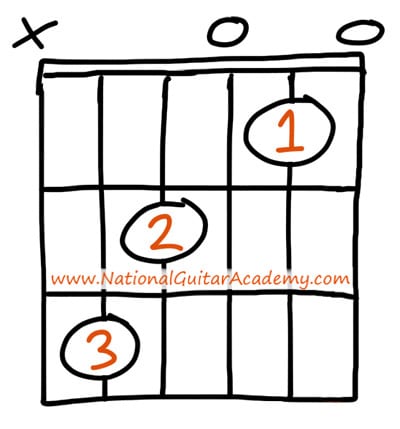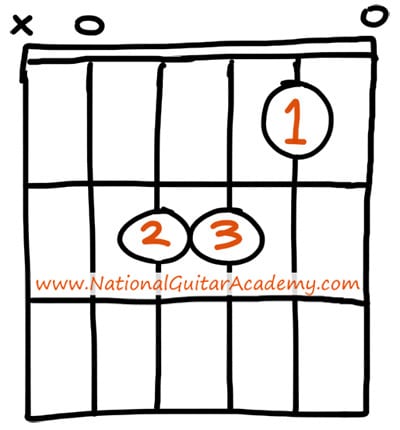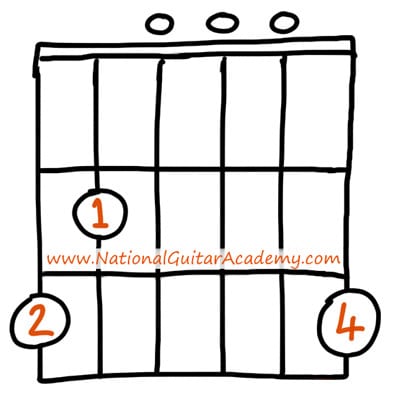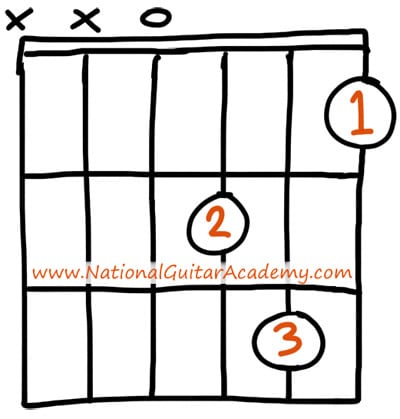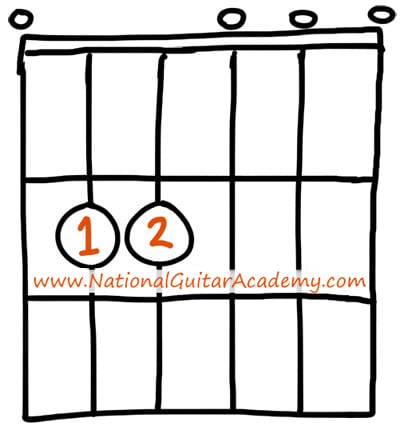Songwriting is a process we can all learn. Are you ready to learn how to write songs with us?
Over 100,000 guitar-learners get our world-class guitar tips & tutorials sent straight to their inbox: Click here to join them
In this free lesson you will learn…
- The cornerstones of songwriting
- An intro to musical intervals
- 2 chord progressions you can put together
- The best way to write melodies
- How to put it all together in a song!
Let’s Learn How To Write Songs!
Songwriting is an art form that’s easy to get into when you have the right resources, but there are a lot of things to consider.
If you’ve been playing guitar for a while and you want to start learning how to write songs, you’ll likely want a bit of foundational knowledge to support you on your journey.
Writing music takes time and consideration – from the chords you choose to the melody you layer overtop, every move you make matters.

Thankfully, it’s easier than ever to practice writing music thanks to the wonders of modern technology, so you can easily bust out the latest recording app on your phone to lay down some ideas to play with.
Some recording apps even let you loop a recording so you can practice fluidly overtop!
With all these wonderful advancements in recording technology in recent years, the only thing we have left to focus on is the process of learning to write songs themselves.
In this lesson, we’re going to give you a solid foundation that will cover all the bases of songwriting in a simple and effective way.
Writing music is all about process, so let’s explore that process in detail.

Learning To Write Songs #1: Understanding Chord Progressions & Chord Similarities
Chords lie at the root of every song in existence – even solo melodies can have chords implied beneath them with ease.
If we’re going to learn how to write songs, we’ll need to understand chords and how they work.
As you know, chords are simply composed of notes stacked together. These notes can move, giving us new chords in the process. When we move notes within chords, or when we move to a different chord, we create motion.
This is an important concept that we’ll keep coming back to, so keep it in mind as you learn to write songs with us.

Let’s take an example of two chords – C major and A minor – and look at the notes they possess:
C Major:
E String: E
B String: C
G String: G
D String: E
A String: C
E String: X
A Minor:
High E String: E
B String: C
G String: A
D String: E
A String: A
E String: X
See the similarities in these two chords?
Not only are the hand shapes similar, but they both possess two E notes. This means they will be easy to play between (it also means that they’re in the same key, which you will need.)

It can then be said that playing these two chords back-to-back creates “good harmonic motion” as they can retain at least one note between them, while changing the other two.
These two chords function well together, and that’s what we want to look for in our chord progressions: chords that function well together.
C MAJOR
(If you don't understand the above image please read our article "How To Read Guitar Chordboxes In 60 Seconds". It will make everything clear!)
A MINOR
Good harmonic motion can be found in all sorts of different chord combinations – try this with all of your favourite chords and compare the notes in them to see what changes/what stays the same.
In order to more easily make sense of the notes within your favourite chords, check out this diagram of the fretboard showing all the notes in their various positions – this will help you greatly in learning to write songs.
Use this to start looking past the chords themselves and into the notes.
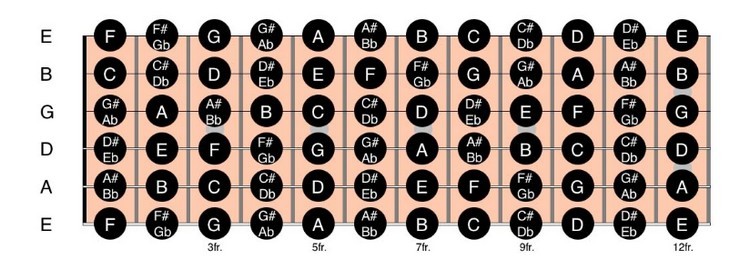
Learn 12 EASY beginner chords with our popular guide

✅ Stop struggling. Start making music.
✅ Learn beginner-friendly versions of every chord.
This is our most popular guide and it will improve your chord ability quickly! 😎
Get your own personalised guitar-learning plan 🎸
Get a custom guitar-learning plan here: Click here for GuitarMetrics™
World-Class Guitar Courses 🌎
Learn from the world's best guitar educators: Click here for our guitar courses
Learning To Write Songs #2: A Little Bit Of Theory
Every key and scale has a series of parameters that we need to follow in order to get a sensibly melodic outcome when we’re learning to write songs.
There are a couple of rules we can follow right out of the gate:
- We want to use chords that fall into the same key
- We want to use chords that compliment each other
- We want to create a good sense of motion between chords
- We want to follow the guideline of chord types in each key

Depending on whether you’re in a major or minor key, the chord types available to you will be slightly different. When we’re learning to write songs, it’s important that we know the chord types in both major and minor keys.
The chord types in a major key (numbered by their intervals) are listed below in the key of C major:
- C Major
- D Minor
- E Minor
- F Major
- G Major
- A Minor
- B Diminished
Now, let’s look at the chord types in a minor key, listed below in the key of A minor:
- A Minor
- B Diminished
- C Major
- D Minor
- E Minor
- F Major
- G Major

Did you see it?
In the key of C major and A minor, the chords are exactly the same – just in a different order.
This is because A minor is known as the “relative minor” of C major, meaning that these two keys will share all the same notes and chords in a different order from one another.
Pro Tip: You can locate the relative minor of any major key simply by moving back three notes from the root of any major key.
This is important because the progression of chords informs the mood of the song we write, and therefore we need to be aware of our chord choice when we learn to write songs.
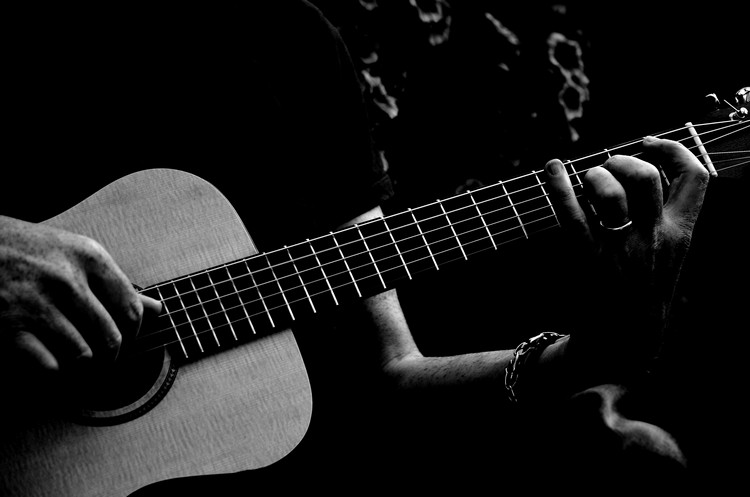
Learning To Write Songs #3: How To Create Motion In Chords
Now that we’ve learned a bit about the intervals and chords within major and minor keys, we can start to put some chords together and work on the motion we talked about earlier.
Although you can certainly learn to write songs using only two chords (or sometimes even one), we’re going to focus on four-chord progressions just so we can really hear the chords move from one to the next.
We’re going to keep with the key of C major for this lesson on learning to write songs, so let’s first look at a chord progression with a tight sense of motion.
Here’s our first example:
C MAJOR
G MAJOR
D MINOR
A MINOR
This chord progression functions well because it allows the notes to move around, creating a nice sense of motion without any huge, dramatic movements.
The C major moves to the G major, and the C on the A string becomes a B. The C on the B string becomes a D in the G major chord as well.
From the G major chord, we hold onto the D on the B string and move to a D minor, providing a stable and easy move.
The G note on the high E string moves back to the first fret, becoming an F. See the small movements we’re making with these notes?
Once we’ve played our D minor chord we move to A minor, once again creating a small set of movements that set up our glorious return to C major.
The D in the D minor on the B string returns to a C note at the first fret for the A minor chord, setting us with the relative minor chord that will give us a triumphant return to the C major chord.
As you can see from this example, learning to write songs is about finding chords that pair well together. To do this effectively, we need to understand musical keys and the chords they contain.
Once we learn these principles, we can string chords together in the same key with confidence.
Try this A minor chord progression on, and look for where each note moves to in the following chord!
Pro Tip: Did you know that many pop songs use the same four chords? Here’s the band “Axis of Awesome” to teach you more about just that- click here.
A MINOR
G MAJOR
D MINOR
E MINOR
Learning To Write Songs #4: Understanding Musical Scales
It’s worth noting at this point that because all of your chords are in the same key, there will be an element of tightness to your chord movement regardless.
This is because most of these chords share notes with one another.
In genres like Jazz, songs are written across multiple musical keys, creating more dramatic chord movements. As impressive as it is, that’s not how we write songs in the beginning.
This puts us at an advantage, though – All this means is that so long as we stay in one key, we can’t lose on the chords we pick.
There’s an art to picking those chords, and it lies in understanding the major and minor scales and their intervals. For this lesson, we’re going to focus on just the major scale for now.

The major scale is composed of seven notes, and each one of those notes holds a specific level of tension in relation to the other notes in the scale.
Our ears naturally want to hear us return to the root of the chord progression, so it’s important to pay attention to the level of tension in each interval and where else it pulls you harmonically.
Interval Stability Chart:
I – Root – Stable Interval
II – Unstable Interval – Can pull us toward either the I or the III
III – Stable Interval
IV – Unstable Interval – Can pull us toward the III
V – Stable Interval
VI – Unstable Interval – Can pull us toward the V
VII – Unstable Interval – Can pull us toward the I

Try This: Play either one of the chord progressions from the previous section, and play the C major scale over top of those chords.
Listen for the tension and release of each note to see how the notes react to the chords you’re playing. This is important when learning to write songs!
You can record the chords with your phone’s recording app, or with a loop pedal if you have one.

Download our lead guitar cheat-sheet to make things easier
It's hard to understand which scales work with which keys.
So we created a cheat-sheet! A key and scale-finder that you can use again and again.

Get your personalised guitar-learning plan 🎸
Get a custom guitar-learning plan here: Click here for GuitarMetrics™
World-Class Guitar Courses 🌎
Learn from the world's best guitar educators: Click here for our guitar courses
Learning To Write Songs #5: Applying Scales To Create A Melody
Now that we’ve covered musical chords, intervals and their appropriate levels of tension as well as a few chord progressions, we can start getting to melody writing.
When we’re learning to write songs, it’s important to pay attention to what we want to sit on top of our chords.
Ever had a melody you’ve just hummed in your head? You can put chords under that! So start humming along to the two progressions above and let’s get started.

Your melody could be played by the guitar, by a piano, a vocalist, whatever you like – but it should do two distinct things:
- Compliment both the rhythm and chord progression of the song you’re writing
- Follow (at least) some of the harmonic motion of the chord progression.
Following these two principles when learning to write songs ensures that your melodies will stick well with your chords, and that they will sound awesome every time.
Pro Tip: We’re purposely not going to give you a riff or melody to play in this section because we want you to make your own. Practice playing the C major scale once again over either of the two chord progressions above, and see what sticks out to you.

#6: Creating Different Sections
Now that we’ve established all of our groundwork between scales, chords, intervals and melodies; there’s one last thing we’ve got to do:
Create a second section!
When we write songs, we often name these sections with letters, like “A” and “B” to help us indicate where we are in the song.
Due to the wonderful fact that both chord progressions above are in the same key, we can use both of them in this song!
Your C major progression will serve as an A section.
The A minor progression will serve as a B section.

B sections allow us to get more creative with our melodies and chord progressions, allowing more space for movement within the confines of the song.
When we’re learning to write songs, leaving room for creativity is important. B sections help with that.
Pro Tip: You can add as many different sections to a song as you like! Get creative with it, especially when you put your lyrics down.

#7: Putting It All Together
Well, we’ve reached the end! You’ve learned all the fundamentals, more or less!
The only thing left to do now is practice, but you can make note of the following principles to make your life a little easier:
- Pay attention to note movement and tension between chords so that your chord changes are always complementary to one another (i.e. don’t use a tense interval if you don’t want tension in that part of your song)
- Follow your ears! It’s important to listen for where chords want to lead to, and often the best solution for the next chord is right in front of you already
- Don’t overcomplicate it – Simplicity is often the best course of action when learning to write songs, so don’t make it hard on yourself.

How To Create A Process To Write Songs
It takes time to create a process for yourself, but by following the principles outlined above you’ll be able to start mastering the art of writing music in no time!
The most important part of all of this is that you not be hard on yourself and give yourself time to learn. Impose melodies over chord progressions, and sing along to what you write.
Learning to write songs doesn’t just make us better musicians, but it improves our ear training in the process as well (which is super important!)
Stay on the path of creativity!
Recommended Resources
Did you enjoy this lesson on learning to write songs?
We’ve got more where that came from. Check out these other great lessons:
- Types of Guitar Pedals
- 8 Tips For Stronger Guitar Fingers
- 10 Best Campfire Songs On Guitar
- The Best Way To Practice Guitar
- The 7 Levels Of Guitar Chord Practice
What Type of Guitarist Are You?
Take our 60-second quiz & get your results: Take The Quiz
Join the world's best online guitar school 🌎
- Get your own personalised guitar learning plan (customised just for YOU).
- World-class online guitar courses. Learn at your own pace.
- Community Campus & Learning Forum - A friendly community! Connect with our team & students. 😊
- Beginner Song library with chordsheets, tabs and tips. (Songs suitable for all levels!)
- Regular live streams, seminars and Q&A sessions - Learn from world-class guitar educators. Get all your questions answered!
Click here to learn more about National Guitar Academy membership 
Cool Guitar T-shirts 😎
Look cooler! Check out our merch: Click here to see our merch store
Want free guitar tips and video lessons delivered to your inbox?
Join over 100,000 guitar-learners and subscribe to our guitar-tips-by-email service. (It's free.)
We'll send you a series of lessons that will move you to the next level of your guitar journey.
Learn how everything fits together quickly, easily and effectively. We share ninja tips (for instant fun!) but also timeless fundamentals that will deepen your understanding.

Popular Lessons
How To Learn Guitar: An 11-Step Programme For Beginners
How To Choose The Perfect Beginner Guitar
More Cool Guitar Stuff
Learn about National Guitar Academy: About Us
Join us on Facebook for daily guitar tips.
Listen to our Learn Guitar Podcast for rapid guitar progress.
Check out our free chord lessons.
Get our best guitar tips & videos
Where should we send it?
Where should we send it?
Get our best guitar tips & videos

